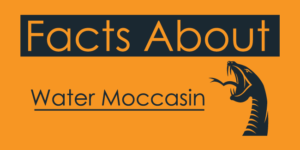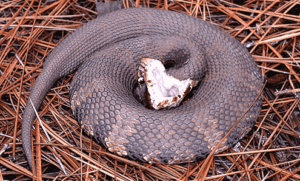
11 Amazing Water Moccasin Facts That You Don’t Know
11 Amazing Facts About Water Moccasin:

Water Moccasin is a North American snake. This is one of the poisonous snakes that bite humans but rarely. But this snake does not bite randomly, it only bites when it feels threat around. Water Moccasin can live on earth as well as in the sea.
If we talk about water moccasin characteristics, it normally possesses a length of about 2-4 meters and a trigonal headlock face.
Not only moccasin but including all the snakes also do not blink their eyes and this can also be a fact.
You probably heard ‘cotton-mouth’ with ‘water moccasin’, these both are the name for the same snake. It is called cotton-mouth because when it opens its mouth, un-intentionally from a distance it looks like there is white cotton.
let’s come to the facts one by one, this way it looks more interesting to You.
Facts About Water Moccasin one-by-one:
Fact #1
Water Moccasin uses its heat sensory organs to detect warm-blooded animals that may become the prey of it. A teenage moccasin has a yellow tip tail that looks like a worm and also teenage moccasin uses it to attract little frogs and tiny fishes that it can hunt easily.
Fact #2
As it is a venomous snake, it possesses exclusive hemotoxic venom in its venom glands which can destroy blood cells and can lead to external bleeding and ultimate death, fortunately, there is an antivenom available.
Fact #3
Water moccasins are ovoviviparous which means females incubate eggs inside their bodies and soon after coming out baby moccasins come out of the eggs.
Fact #4
The scientific name of Cotton-mouth is Agkistrodon Piscivorus and it belongs to the kingdom Animalia and yet there are three sub-species of cottonmouth that are discovered which are; Florida cottonmouth, Eastern, and Western cottonmouth.
Fact #5
Water Moccasin is famous for its aggressive nature but it rarely bites humans, they are specifically self-defense focused snakes which means they only bite when they feel threat around.
Fact #6
If the cottonmouth coils around itself is a sign that it is threatened and can bite anytime, also when it coils like this, it widely opens its mouth to expose its inner white of the mouth to warns back its predator.
Fact #7
The lifespan of a cottonmouth ranges from 15-20 years or it can live a maximum of 24.5 years life.
Fact #8
Cottonmouth often stays near the marshy areas or the areas near water streams, also these are the snakes that hibernate during the winter season.
Fact #9
It is also a fact that the species of cottonmouth are not endangered even its population is going stable ahead.
Fact #10
Before a predator attacks cottonmouth, it sprays a foul smell liquid as the ultimate warning to its predator.
Fact #11
The female cottonmouth gives birth to around 16 offsprings.

How to identify a Water Moccasin?
To identify a water moccasin there are many things to be noticed as the first thing is its whitish inner mouth due to which it is known as cottonmouth. The other things are as follow:
- It has dragon-like eyes.
- The pupil in the eyes is verticle.
- Water moccasin can change its body shape to flat or round.
- There are two single alternate lines of belly scales till the tail.
These are some special characteristics of a cottonmouth snake that anybody can use to identify.
What are the symptoms of cottonmouth bite
Almost all venomous snake bites have similar symptoms including the symptoms of cottonmouth bite. Following are the typical indications of a venomous snake bite:
- Difficulty in breathing.
- Nausea and vomiting.
- Salivating and sweating.
- Blurred vision and numbness on the face.
- Severe pain at the bite site.
You may also enjoy reading: